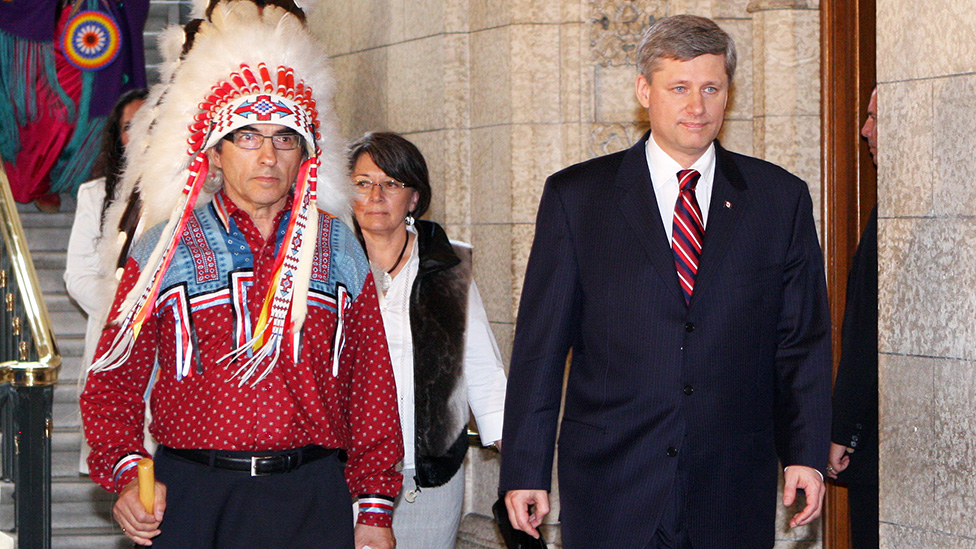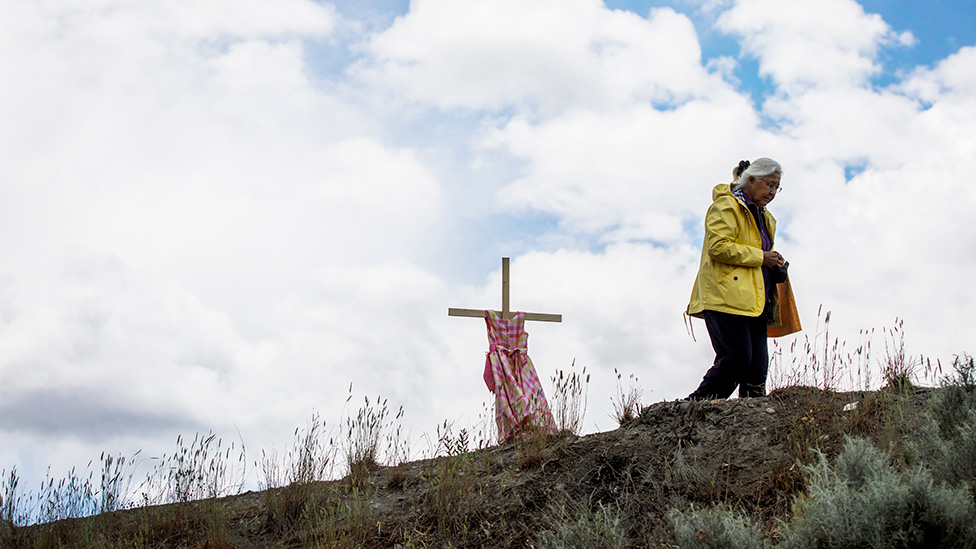Sonoma County Family Youth and. Children Services Corruption
Why Canada is mourning the deaths of hundreds of children
By Holly Honderich
BBC News, Washington
Image source, Getty Images
The discovery has prompted an outpouring of grief
The discovery in May of the show of remains of 215 Indigenous children - students of Canada'due south largest residential school - prompted national outrage and calls for farther searches of unmarked graves.
Since and so, more unmarked gravesites take been institute, providing previews of investigations by Canada'south First Nations into the deaths of residential schoolhouse students.
A rising tally of these graves - more than i,100 then far - has triggered a national reckoning over Canada'due south legacy of residential schools. These government-funded boarding schools were part of policy to attempt to assimilate Indigenous children and destroy Ethnic cultures and languages.
Here's what nosotros know about the findings so far.
What do we know about the 215 graves?
In May, Tk'emlúps te Secwépemc Chief Rosanne Casimir announced that the remains of 215 children had been found well-nigh the urban center of Kamloops in southern British Columbia (BC) as part of a preliminary investigation.
Some of remains are believed to be of children as immature as three.
All of the children are believed to take been students at the Kamloops Indian Residential Schoolhouse - the largest such institution in Canada'southward residential school system.
The remains had been confirmed with the help of ground-penetrating radar engineering science, Chief Casimir said, following preliminary work on identifying the burial sites in the early 2000s.
The full written report into the remains constitute is due on Th, and the before findings may be revised. Indigenous leaders and advocates take said they expect the 215 effigy to rise.
"Regrettably, we know that many more than children are unaccounted for," said Chief Casimir in a argument.
Thousands of children died in residential schools and their bodies rarely returned abode. Many were buried in neglected graves.
To this day there is no full picture of the number of children who died in residential schools, the circumstances of their deaths, or where they are buried. Efforts like those of the Tk'emlúps te Secwépemc First Nation and others are helping to slice some of that history together.
The Kamloops school, which operated between 1890 and 1969, held upward to 500 Indigenous students at whatever 1 time, many sent to live at the schoolhouse hundreds of kilometres from their families. Between 1969 and 1978, it was used as a residence for students attending local day schools.
Of the remains establish, 50 children are believed to take already been identified, said Stephanie Scott, executive director of the National Centre for Truth and Reconciliation. Their deaths, where known, range from 1900 to 1971.
But for the other 165, there are no available records to mark their identities. Children "ended up in pauper graves," Ms Scott said. "Unmarked, unknown."
What about the other sites?
In June, the Cowessess First Nation in Saskatchewan appear it had establish an estimated 751 unmarked graves afterward a like investigation - the largest such discovery to date. The remains were institute near the onetime Marieval Indian Residential School, which operated from 1899 to the 1990s and under the control of the Roman Catholic Church building for much of that time.
Cowessess leaders have not yet determined if all the unmarked graves belonged to former students. Technical teams volition continue the investigation to provide verified numbers.
Cowessess Main Cadmus Delorme emphasised that the discovery was of unmarked graves - non a mass grave site - and suggested that the Catholic Church may have removed grave markers at some point in the 1960s.
A week later, the Lower Kootenay Band in British Columbia said the remains of an additional 182 people had been found near the grounds of the sometime St Eugene'south Mission Schoolhouse. St Eugene's was operated by the Cosmic Church from 1912 until the early 1970s.
"No reconciliation without truth": A survivor recounts abuse in Canadian residential school
And in mid-July, the Penelakut Tribe in British Columbia said it had identified some 160 "undocumented and unmarked graves" on their grounds and foreshore most the former site of the Kuper Island Industrial School. They offered few details, though the tribe has been working with researchers in recent years to find potential gravesites.
What are residential schools?
The Kamloops residential school was one of more than 130 others like it. The schools were operated in Canada between 1874 and 1996.
A linchpin in the government's policy of forced assimilation, some 150,000 Showtime Nations, Métis and Inuit children were taken from their families during this flow and placed in state-run boarding schools.
The policy traumatised generations of Indigenous children, who were forced to abandon their native languages, speak English language or French and convert to Christianity.
Christian churches were essential in the founding and operation of the schools. The Roman Cosmic Church in detail was responsible for operating upwards to 70% of residential schools, according to the Indian Residential School Survivors Society.
"It was our government's policy to 'get rid of the Indian' in the child," said quondam National Principal of the Associates of First Nations Perry Bellegarde. "It was a breakup of cocky, the breakup of family unit, customs and nation."
Timeline: The central dates
Canada's first prime number government minister, Sir John A Macdonald, authorises the creation of a residential school system, established by Christian churches and the federal authorities, with the intent to assimilate indigenous peoples in Canada.

Residential schools are fabricated compulsory for children from age 7 to 15. Some 150,000 Commencement Nations, Metis and Inuit children are eventually taken from their homes, with many parents surrendering them under threat of prosecution.

The residential school system begins to wind downward - though the last school will close in 1996 - every bit the psychological and cultural impacts of the schools come up under growing scrutiny.
An estimated 6,000 children die at the schools, according to the erstwhile chair of Canada'southward Truth and Reconciliation Committee Murray Sinclair. They die from causes similar affliction, neglect, or accidents. Physical and sexual abuse is also common.
In that location is nonetheless no full flick of the number of children who died or where many of them are cached.
Canadian Prime Minister Stephen Harper problems a formal apology for the residential school organisation, which saw over 130 such institutions operating beyond Canada.
"Today, we recognise that this policy of assimilation was wrong, has caused neat harm, and has no place in our land," he says.

The Truth and Reconciliation Commission of Canada releases its final report on the legacy of residential schools and describes the key policy behind the system every bit one of "cultural genocide". Information technology recommends funding to notice burial sites and commemorate the children who died abroad from home.
Tk'emlúps te Secwe̓pemc First Nation in British Columbia announces that a preliminary investigation, using ground penetrating radar, has establish an estimated 215 unmarked graves at the site of a erstwhile residential school. Other Offset Nations in Canada are conducting similar research.

The landmark Truth and Reconciliation Commission (TRC) report, released in 2015, detailed sweeping failures in the care and safety of these children, and complicity past the church and government.
"Government, church and school officials were well enlightened of these failures and their bear upon on educatee health," the authors wrote. "If the question is, 'who knew what when?' the clear answer is: 'Anybody in authority at any point in the system'due south history.'"
Students were frequently housed in poorly congenital, poorly heated, and unsanitary facilities, the report said. Many lacked access to trained medical staff and were subject area to harsh and often abusive punishment.
The squalid health conditions, the written report said, were largely a function of the government'due south resolve to cut costs.
"We have records in our archives of school administrations arguing with the Indian affairs government at the time nigh who was going to pay for the funerals of students," Ms Scott said. "They would practice information technology all at minimal expense."
What practise we know about the search for missing children across Canada?
Research by the TRC found that thousands of Indigenous children sent to residential schools never made it home.
Physical and sexual corruption led some to run away. Others died of illness or by accident amid neglect. As tardily as 1945, the decease rate for children at residential schools was almost five times college than that of other Canadian schoolchildren. In the 1960s, the rate was still double that of the general student population.
Image source, Getty Images
Children'due south shoes have been left at makeshift memorials across Canada
"Survivors talked almost children who suddenly went missing. Some talked well-nigh children who went missing into mass burial sites," said former TRC chair Murray Sinclair in a statement in May.
Other survivors spoke of infants fathered past priests at the school, taken from their mothers at nascency and thrown into furnaces, he said.
The TRC identified 3,200 confirmed deaths, though it noted that the work of identification and commemoration was "far from consummate". Mr Murray estimated some six,000 children may have died.
What has been done?
In 2015, the TRC issued 94 calls to activeness, including six recommendations regarding missing children and burial grounds. Prime Minister Trudeau promised to "fully implement" all of them.
- According to a running count past the CBC, 10 of the projects accept been completed, 64 are in progress and xx take not begun
- The TRC, struck in 2009, fought for the event of unmarked burial sites to be included in its mandate
- In 2019, the government committed C$33.8m ($28m; £19.8m) over iii years to develop and maintain a school student death register and set up an online registry of residential school cemeteries
- So far, the National Centre for Truth and Reconciliation says it has received just a fraction of this money though "discussions are ongoing"
What has been the reaction?
In early on July, Mr Trudeau visited Cowessess First Nation and said it was "shameful" that children died because of residential schools and the "legacy of inter-generational trauma" caused by the policy.
Ms Scott, along with Chief Bellegarde and other Indigenous leaders, have pressed the authorities for a thorough investigation of all 130 former school sites to find whatever unmarked graves.
"Trudeau has been willing to motion on this, he's got a lot of words, but we actually need to come across activeness," said Ms Scott.
Paradigm source, Getty Images
First Nations community members gather for a vigil in Marieval after a discovery of unmarked graves
The discoveries also cast a shadow over the land'south 1 July Canada Day holiday. Municipalities across Canada called off celebrations this yr in recognition of the findings.
The preliminary findings have too renewed demands for an apology from the Catholic Church - ane of the calls to action in the TRC report.
In 2017, Mr Trudeau asked Pope Francis to apologise for the church's part in running Canada's residential schools - but the church has so far declined.
The United, Anglican and Presbyterian churches issued formal apologies in the 1980s and 1990s.
News of the BC discovery also spurred a global response, prompting statements from Human Rights Spotter and the United Nations.
Source: https://www.bbc.com/news/world-us-canada-57325653


0 Response to "Sonoma County Family Youth and. Children Services Corruption"
Post a Comment